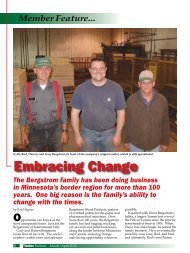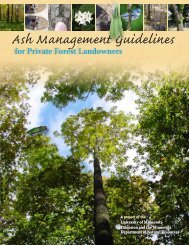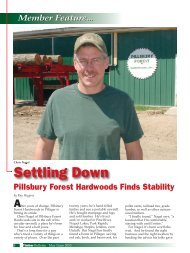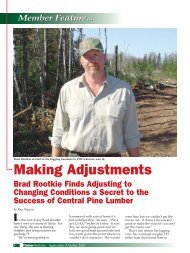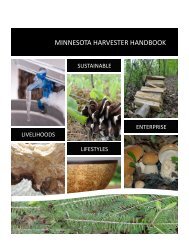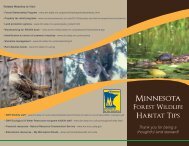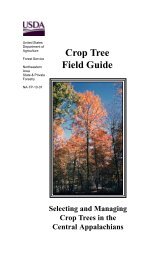Ash Management Guide for Private Forest Landowners
Ash Management Guide for Private Forest Landowners
Ash Management Guide for Private Forest Landowners
Create successful ePaper yourself
Turn your PDF publications into a flip-book with our unique Google optimized e-Paper software.
A general overview of ash species dominance in Minnesota’s <strong>for</strong>est systemsWet <strong>Forest</strong> system Floodplain <strong>Forest</strong>systemMesic Hardwoodsystem<strong>Forest</strong>ed RichPeatland systemFire-DependentsystemMain tree speciesin system<strong>Ash</strong> species andits dominanceCharacters thatshape thissystemGreen and black ash,northern white cedar.Sometimes balsamfir, American elm, redmaple.<strong>Ash</strong> and white cedardominate these sites. Allsites have ashregeneration and 75%have ash trees on them.In an average stand, ashcontributes 34% of thetrees.Found along margins oflakes, rivers and peatlands.Stands can alsooccur in shallow depressionswhere the watertable is high. Waterpeaks in the spring anddecreases in depththroughout the summer.This seasonal variabilityof water is the hallmarkof the wet <strong>for</strong>est system.Soils Soils are under wateror saturated during thegrowing season. Thislimits the oxygen andnutrient availability andthe rate of decomposition.So a mucky layer iscreated on the surface ofthe soils. Peat, if <strong>for</strong>med,only reaches a depth of10 to 40 inches.Shrubs and vines Rough alderMountain mapleBeaked hazelnutRed-osier dogwoodSwamp red currentVirginia creeperDwarf raspberrySilver maple, Americanelm, green ash, blackash, hackberry, basswood,boxelder, whiteash.<strong>Ash</strong> seedlings occur on95% of the sites. <strong>Ash</strong>trees are found on 88%of the sites. Green ashaccounts <strong>for</strong> 16% of thetrees. Black ash, in thenorth, accounts <strong>for</strong> 21%of the trees.Regular inundation byspring floods. Commonlyfound on flatlands along streams andrivers. Tree stems androots must withstand alot of mechanical damage.Lots of nutrients aredeposited in soils witheach flood. Mucky layersdo not accumulateon the soil surface.Wild GrapeVirginia creeperCanada moonseedNote:Shrubs are generallyabsent from floodplain<strong>for</strong>ests.Sugar maple and basswood,paper birch, quakingaspen, red oak, yellowbirch, white ash, greenash, black ash, ironwood,red maple.<strong>Ash</strong> is common. 66% ofsites have ash seedlings.<strong>Ash</strong> occurs as trees on25% of the sites. In anaverage stand, about 10%of the trees are ash; green,black and, rarely, whiteash which only occurs inthe southeastern counties.Wildfires are very infrequent.The limiting factoris sunlight because thecanopy is continuous,dense, and multi-layered.Soils are able to retain waterso many tree speciescan grow there. Nutrientsare rapidly recycled.Beaked hazelnutMountain mapleChokecherryPagoda dogwoodPrickly gooseberryDowny arrowwoodJuneberryFly honeysuckleLowland conifer dominated;tamarack, northernwhite cedar, black spruce,balsam fir, paper birch, redmaple and black ash common,but considered to be‘misplaced’ or ‘off site’.Poor habitat <strong>for</strong> ash. Itspresence is likely where ashroots can reach the mineralsoil. Seedlings are commonbut only 4% make it to treesize.Occur on deep and actively<strong>for</strong>ming peat. Sphagnummoss is most common peat<strong>for</strong>mer.Deep peat soils. Soils arecontinuously water-loggedso they are acidic, havelow oxygen and are poor innutrients.Rough alderBog birchRed-osier dogwoodCranberryLabrador teaCreeping snowberryMountain flyHoneysuckleAlder-leaved buckthornPredominately upland conifers.Jack, red, and whitepines, quaking aspen, paperbirch, white spruce, bur oak,northern pin oak, northernred oak, bigtooth aspen, redmaple. Some balsam fir.Historically, ash was veryinfrequent. With fire-suppressionin the last century,ash has an increased itspresence. Primarily greenash. 20% of sites have ashseedlings but only 3% haveash trees.Wildfires kill trees, set conditions<strong>for</strong> regeneration,episodic release of nutrientsover decades of time.Dry soils that are nutrientpoor due to a long history ofwildfires. Nutrients also lostthrough leaching down intothe soil.American hazelnutPoison ivyTall blackberrySand cherryWintergreenPrairie willowWild roseJuneberriesGrey dogwoodSnowberryFerns and related Lady fern Ostrich fern Lady fern Marsh fern Lady fernThis is your field copy – take it with you into the woods and ID your ash system.



